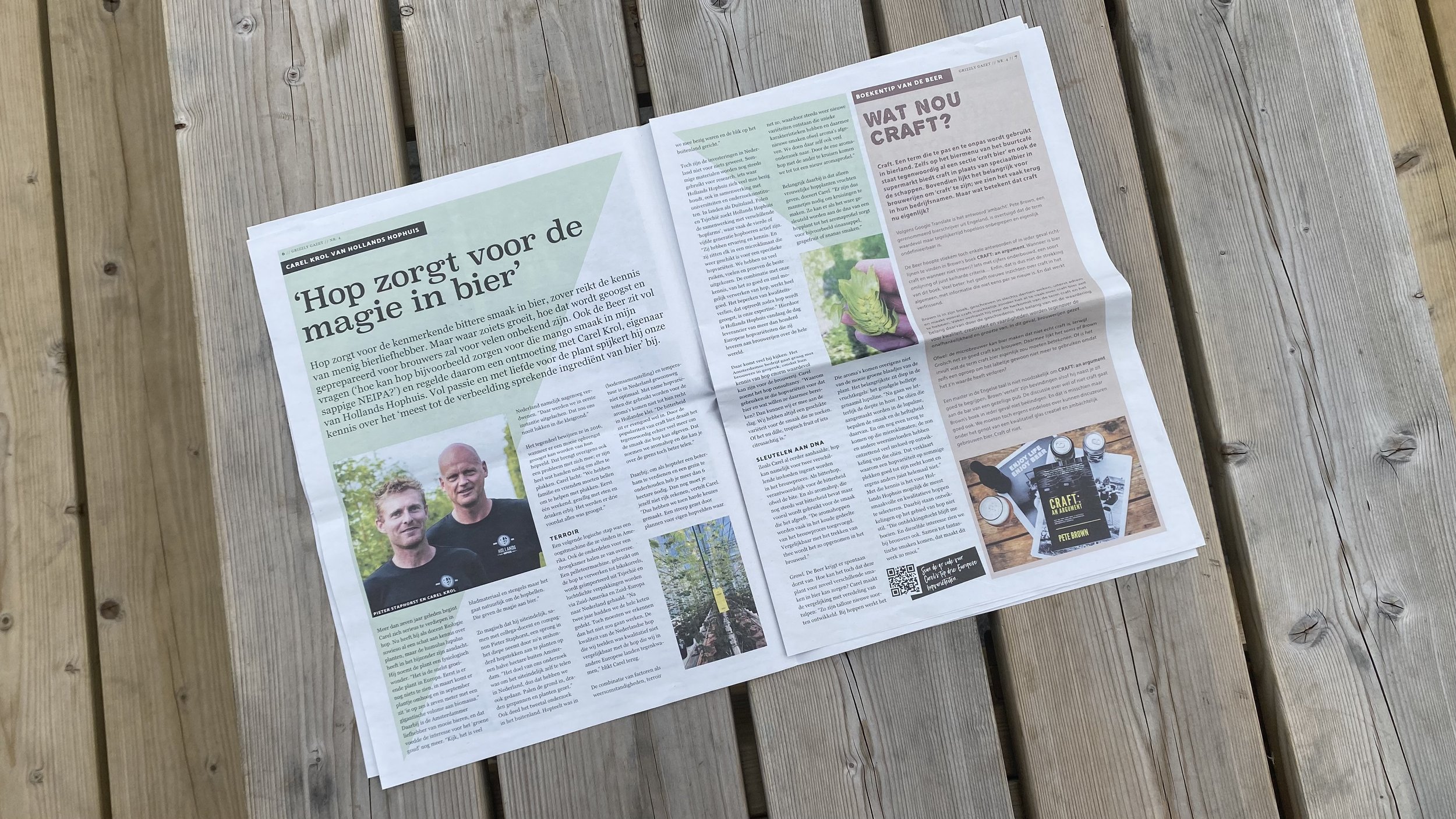Hoppy Grizzly Gazet Article
Carel from Hollands Hophuis talks with De Grizzly Gazet, the in-house magazine of Dutch online beer shop Beer in a Box. This is a translation of the full interview, learn more about how we became who we are today:
“Hops put the magic in beer”
Hops are responsible for the characteristic bitter flavour in beer; many beer lovers are aware of this. But where it grows, how it' s harvested and how it's prepared for brewers is unknown to many. The Beer is also full of questions ('how can hops for instance provide that mango flavour in my juicy NEIPA?') and therefore arranged a meeting with Carel Krol, owner of Hollands Hophuis. Full of passion and love for the plant, he brushes up our knowledge on the 'most imaginative ingredient of beer'.
More than seven years ago, Carel started to seriously investigate hops. As a biology teacher, he already has a great deal of knowledge about plants, but humulus lupulus is of particular interest to him. He calls the plant a physiological miracle. "It is the fastest growing plant in Europe. At first there is nothing to see, then in March the plant pops up and by September it is six to seven metres tall with a huge volume of biomass." In addition, the Amsterdam-based Dutchman is a lover of fine beers, and this fuelled his interest in the 'green gold' even more. " It's a lot of leaf material and stems but of course it's all about the hop cones. Those give the magic to beer."
So magical, in fact, that he eventually took a leap of faith, together with fellow teacher and associate Pieter Staphorst, by planting about six hundred hop plants on half a hectare outside Amsterdam. "The aim of our research was to eventually grow it ourselves in the Netherlands, so that's what we did. Poles in the ground, wires stretched and plants planted." The two of them also conducted research abroad. Hop cultivation had virtually disappeared in the Netherlands. "We were initially laughed at. We would never be able to do it in this Dutch clay soil."
They proved the opposite in 2016, when a nice yield can be harvested from their hop field. That also comes with a bit of a problem, by the way; it takes a lot of hands to harvest everything. Carel laughs: "We had to call family and friends to help with the picking. At first, it was just one weekend, with lots of food and drink. It took three before everything was harvested."
(Text continues below image)
Terroir
The next logical step was a harvesting machine that they found in America. They also get the parts for a drying room from overseas. A pelletising machine, used to process the hops into bicker pellets, is imported from the Czech Republic and airtight packaging is brought to the Netherlands via South America and Southern Europe. "After two years, we had the whole chain covered. Nevertheless, we had to admit that it was not going to work. The quality of the Dutch hops we grew was not comparable to the hops we found in other European countries," Carel recalls.
The combination of factors such as weather conditions, terroir (soil composition) and temperature is simply not optimal in the Netherlands. In particular, hop varieties that are used for aromas do not flourish in Dutch clay. "The bitterness is still there. However, the popularity of craft beer nowadays means that it is much more about the flavour that hops can impart. That's what we call aroma hops and you can grow them better across the border."
Besides; to earn a living as a hop grower and support a family you need more than 6 hectares. Even then, you shouldn't count yourself rich, Carel says. "So we made some tough choices. We drew a line under plans for our own hop fields that we were working on and turned our attention to other countries."
Yet the investments in the Netherlands have not been for nothing. Some materials are still used for research, something Hollands Hophuis is very much involved in, also in cooperation with universities and research institutes. In countries such as Germany, Poland and the Czech Republic, Hollands Hophuis seeks cooperation with various hop farms, where often fourth or fifth generation hop farmers are active. "They have experience and knowledge. And they are each located in a microclimate that is suitable for a specific hop variety. After much smelling, feeling and tasting, we have chosen the best. The combination with our knowledge, of processing hops as well and as fast as possible, works very well. Limiting quality loss, which occurs as soon as hops are harvested, is our expertise." As a result, Hollands Hophuis is today a supplier of more than a hundred European hop varieties, which they supply to breweries all over the world.
There is a lot that comes with that. The Amsterdam-based company likes to talk to brewers, because their knowledge of hops can be extremely valuable to the brewery. Carel calls it hop consultancy. "Why do they use that hop variety for that beer and what do they want to achieve with it? Then we can get to work on it. We always have a suitable variety for the flavour they are looking for. Whether it's dill, tropical fruit or something citrusy."
(Text continues below image)
Tinkering with DNA
As Carel mentioned earlier, hops can be used for two different influences in the brewing process. As bitter hops, responsible for the bitterness or the bite. And as aroma hops, which still contain some bitterness but are mainly used for the flavour they impart. "The aroma hops are often added in the cold part of the brewing process. Similar to the brewing of tea, it is incorporated into the brew."
Growl. It makes the Bear spontaneously thirsty. How is it possible that this plant can create so many different flavours in beer? Carel makes the comparison with the breeding of tulips: "That's how countless new varieties were developed. It works the same way with hops, so that new varieties are constantly being created that have unique characteristics and therefore give off new flavours or aromas. We do a lot of research into this ourselves. By crossing one aroma hop with another, we come up with a new aroma profile."
It is important to note that only female hop plants give fruit, the hop cones, Carel teaches. "So males are needed to make crosses. In this way, the dna of a hop plant can be tweaked, so to speak, until the aroma profile produces orange, grapefruit or pineapple flavours, for example."
Those aromas don't come from the plant's pretty green leaves. The main thing is deep in the hop cones, the little golden-yellow ball called lupulin. "Now we are literally going into the depths of things. The oils that are produced in the lupulin determine the flavour and the intensity of it. And to come back to microclimates: the sun and other weather conditions have an enormous influence on the development of these oils. That explains why a hop variety performs well in some places and not at all in others. With this knowledge, Hollands Hophuis is able to select the most tasteful and qualitative hops. Developments in the field of hops never stand still. "That voyage of discovery continues to fascinate me. And we see the same interest among brewers. Coming up with fantastic flavours together, that is what makes this work so wonderful."



